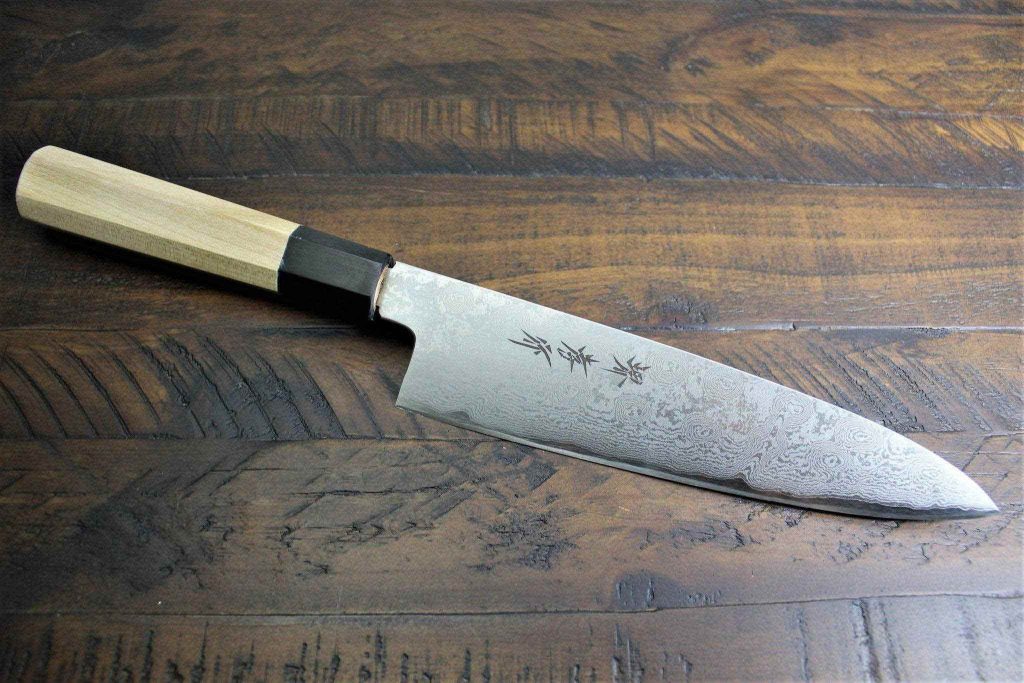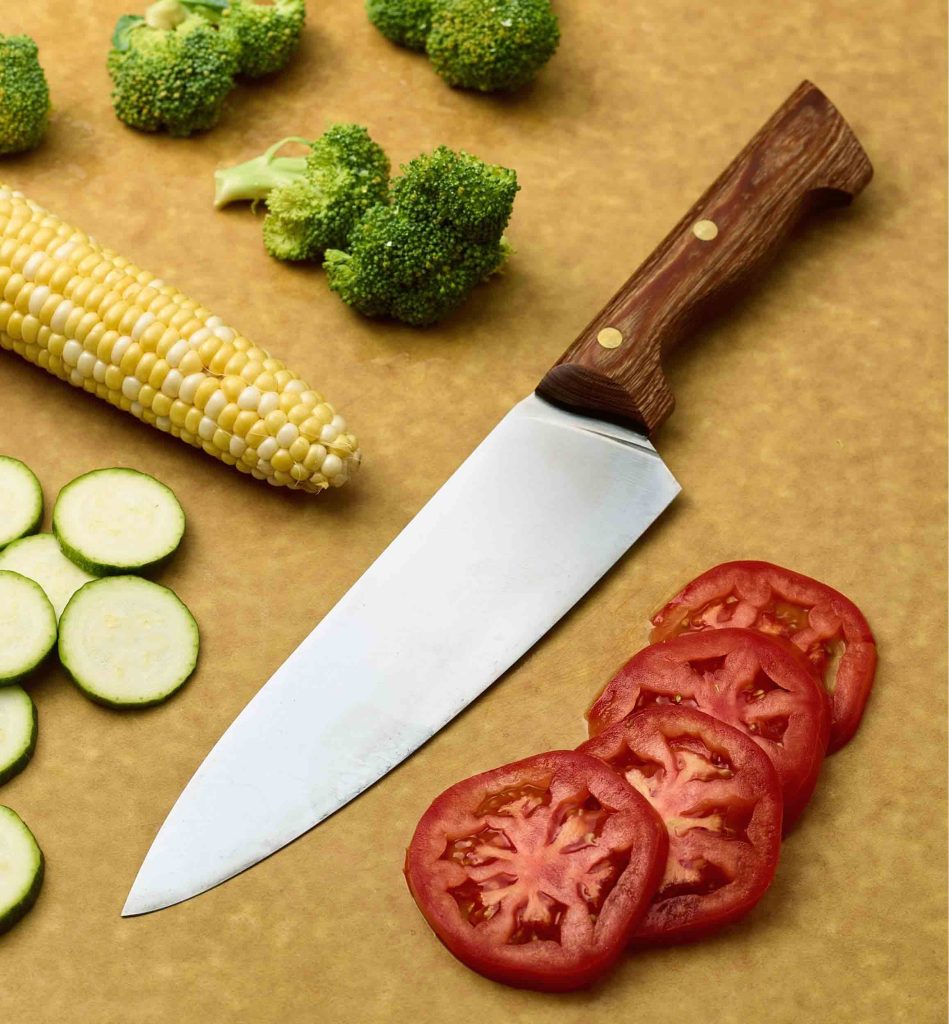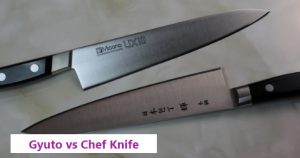If you are fond of cooking and spend your time in the kitchen then you probably know the gyuto and chef knives. But the question is which knife is a better option for you? As every knife has pros and cons and to decide which knife is right for you depends upon your preferences and needs. In this article, we are comparing both knives so you can make the final decision which one is perfect for you.
What is a Gyuto Knife ?
A gyuto knife is a japanese chef knife which is used for performing different tasks like slicing, dicing and mincing. The gyuto knife has length between 210 mm to 270mm and its blade is made with carbon steel or stainless steel. The main reason of its popularity is its sharpness, The blade is very finely ground on the edge. The gyuto knife is also known for its versatility and also used for western cooking and traditional japanese kitchens.
What is a Chef Knife ?
The chef knife is a type of kitchen knife which is designed for doing general purpose chopping and slicing. It usually has a wide, curved blade that tapers to a point, making it ideal for cutting tough meats and vegetables. It also has a bolster, which is a thickness of metal near the base that provides extra strength and stability. Beside its versatility, the chef knife is also known for its durability and comfort. Its broad blade provides users more control over cuts and the bolster prevents the hands from fatigue. Because of these facts, a chef knife has been an important ingredient in any kitchen.
What are the Differences Between Gyuto Knife and Chef Knife?
Now it’s time to discuss the basics of each knife and then we will compare and contrast them.
Size of Knives
The most manifest difference between gyuto knife and chef knife is their sizes. The gyuto knives are larger, having blades of 210mm to 270mm length. It makes them a great choice for different tasks with more precision such as slicing and dicing. While the chef knives are shorter in length and its blade comes with 180mm to 210mm. This is a suitable knife for general purpose chopping and slicing.
Shapes of Blade
Another difference between gyuto and chef is the shape of blades. The gyuto knife has a flatter blade while the chef knife has a curved blade which is taper to point. The straight blade of the Gyuto knife facilitates a push/pull mechanism while performing cutting and is perfect for chopping. The curved blade of a chef’s knife, on the other hand, provides more control with a fine tip that helps with rock cutting and roll cutting.
Tips of Knife
The tip of the chef knife is more pointed as compared to the tip of gyuto knife. It provides more accuracy during cutting but it also makes it difficult to control the chef knife. On the other hand, The gyuto knife has blunt tips which make it easier to control and the kit is less like puncturing your components at the top of the board.
The Handle
Typically the gyuto knives have wooden handles with concealed tang construction while the chef knives have ligneous or composite handles with full tang construction. The selection of handles depends upon your personal preference. However, some people find that wooden handles are more comfortable to hold, while others prefer the added weight and stability of a full tang handle… it all up to those people who will use them.
Cost
Gyuto knives are slightly more expensive than chef knives, because these knives are made with higher quality material and require more while manufacturing it. If you are looking for a high quality knife that will last a long time, the Guyto knife is a good option. However, if you have a fixed budget, a chef knife is a better choice.
Also Read: https://knifeplatoon.com/how-much-do-kitchen-knives-cost/
Weight
As the gyuto knife is made up of high quality material that’s why it is lighter than a chef knife. It also has a thinner blade and light construction which make it quick moveable. Furthermore, chef knives with full tang handles are heavier than gyuto knives. If you are looking for a knife that is easy to control, a chef knife is a better option. And if you want a knife which can work for long lasting then you should move to gyuto knife.
Grip Offered
Holding the gyuto knife is different from the way you grab the chef knife. Because of the blade’s structure, you’ll usually grip a Gyuto knife near the base of the blade. This provides more control over cutting. On the other hand, you can hold the chef knife with your index finger and thumb grabbing the blade and the rest of the hand gripping the handle. This makes it more versatile and gives an accurate cut to chopped vegetables.
Sharpening the Knives
Gyuto knives are made with rigid steel which means they can hold an edge for longer but its blades are difficult to sharpen. While the chef knives are made with softer steel that make it easy to sharpen but it requires more sharpening from time to time.
Check it: https://knifeplatoon.com/how-to-sharpen-chef-knife/
Finishing of Knives
The finish of gyuto knives is more polished than that of chef’s knives, it is because they are made with high quality material and need more time and skill to manufacture. Chef’s knives, on the other hand, have a more plain finish. This is because they are made with less expensive materials and construction, and require less time and skill to produce.
Gyuto knife Recommendation
Highly recommend this gyuto knife, Tojiro DP Gyuto – 8.2. It is good in price and features a riveted handle and performs very well.

Chef’s knife Recommendation
It’s hard to go wrong with this chef’s knife, Victorinox Fibrox Pro 8 inch. It is a great choice from performance to price and work for a long while.

Final Verdict
The main things to worry about these knives are weight and handle design. Aside from these two factors, gyuto knives and chef knives are pretty much interchangeable when it comes to everyday kitchen tasks. Remember that western knives generally require a gentler movement for effective cuts. Gyuto knives work best with an up and down motion. Just be sure to find a handle design and weight distribution that works for you!

